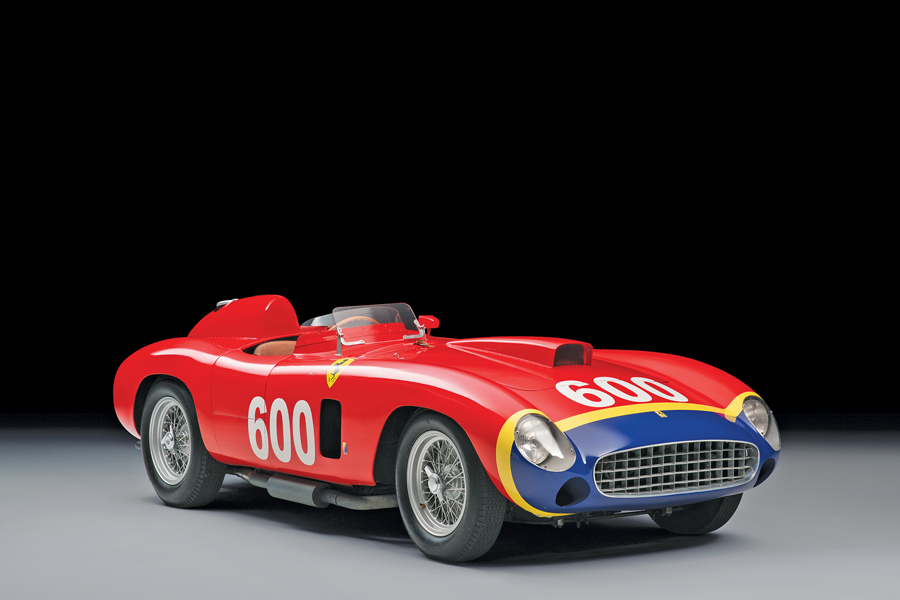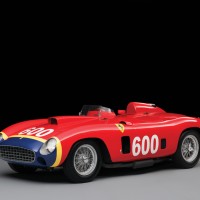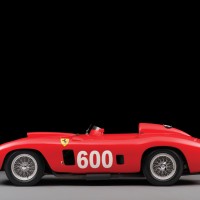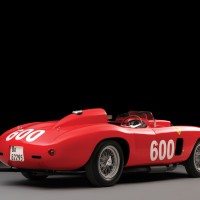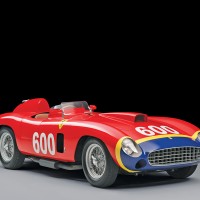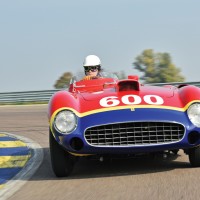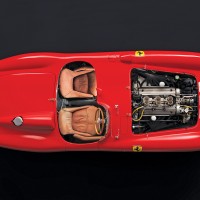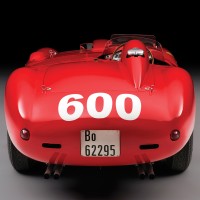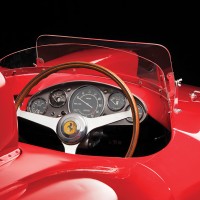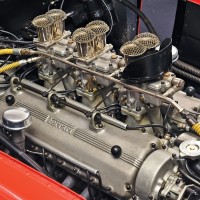SCM Analysis
Detailing
| Vehicle: | 1956 Ferrari 290 MM by Scaglietti |
| Years Produced: | 1956 |
| Number Produced: | Four |
| Original List Price: | N/A |
| SCM Valuation: | Median to date: Does not apply, as there is only one sale — this one — in SCM’s Platinum Auction Database; high sale, $28,050,000 (this car) |
| Tune Up Cost: | $4,000 |
| Distributor Caps: | $450 (requires four) |
| Chassis Number Location: | Left frame member by steering box |
| Engine Number Location: | Right rear of block |
| Club Info: | Ferrari Club of America |
| Website: | http://www.ferrariclubofamerica.org |
| Alternatives: | 1956 Ferrari 860 Monza, 1959 Ferrari 250 Testa Rossa, 1956 Maserati 300S, 1956 Mercedes-Benz 300SL Alloy |
| Investment Grade: | A |
This car, Lot 221, sold for $28,050,000, including buyer’s premium, at RM Sotheby’s “Driven By Disruption” auction in New York, NY, on December 10, 2015.
The sale of Ferrari 290 MM 0626 was the top auction sale of 2015. It is also the third-most-expensive automobile ever sold at auction.
Most people can understand a Ferrari 250 GTO topping the list. With a little education, they can even understand the Mercedes-Benz W196 being number two. But how does a car that you couldn’t pick out of a lineup become one of the most expensive cars on the planet?
Ferrari covers all the bases
The 1956 World Sports Car Championship was based on five races: the Buenos Aires 1000 Kilometers, the 12 hours of Sebring, the Mille Miglia, the Nürburgring 1000 Kilometers, and the Grand Prix of Sweden.
Many Ferraris competed for the title, but it would be the factory team that would finish the job.
The 1956 Championship rules allowed for engines of up to 3.5-liter displacement. Ferrari hedged its bets and ran two models: the 860 Monza and the 290 MM.
The cars had nearly identical underpinnings and similar bodies; however, they were powered by substantially different engines.
Both engines were approximately 3.5 liters, but they differed dramatically in design and performance. The 860 engine was a Lampredi-style inline 4-cylinder unit with stump-pulling torque. The 290 engine was a V12 that aced out the 860 with 320 horsepower.
Lots of power and a couple of quirks
The 290 MM had, quite literally, a killer quirk. For unknown reasons, its gas pedal was positioned between the brake and clutch pedal. Two serious 290 MM accidents were attributed to the driver pressing on the gas instead of the brake. In one case the crash was fatal.
The small-piston V12 had little engine braking compared to the big-bore 4-cylinder unit. Duncan Hamilton tells the story in his book Touch Wood.
Ferrari had hired Hamilton to drive an 860 Monza at the Grand Prix of Sweden.
During a practice session, he switched to a 290 MM for a couple laps. Another driver warned him that “lifting one’s foot off the accelerator made not the slightest bit of difference once the 12-cylinder cars were in fifth gear.” Hamilton agreed after missing a corner and “taking to an escape road at speed, entering a back yard, passing between two adjacent cottages, crushing a dustbin, killing a chicken, and demolishing an outside loo.”
Hamilton’s wonderfully entertaining account of the weekend also includes details of an after-race party that goes on until dawn with stolen whiskey and antics that would make a rock band proud.
Where’s the value?
Some cars are valuable for what they are, some are valuable for what they did and some are valuable for who owned or drove them. Our subject 290 MM checks all the boxes.
Campaigning a top sports car team in an international competition is no small endeavor. Moving drivers, equipment and personnel in the age of prop planes and teletypes involved skills that can hardly be imagined.
Enzo Ferrari created his company solely to compete in international racing. He didn’t do it to promote a line of street cars — he did it to sell racecars to racers. His even-serial-number cars were single-purpose race cars designed from scratch to beat the competition anywhere on the planet.
As a factory team car, chassis 0626 was built with every unfair advantage the factory could muster.
Chassis 0626 has an excellent competition history. It won the 1957 Grand Prix of Buenos Aires and placed well in many other races.
Many of the top drivers of the era drove the car, including world champions Juan Manuel Fangio and Phil Hill. It also has a clean history with no major shunts, and virtually all of its important parts are original.
Collecting old race cars is a very esoteric hobby. It requires a broad knowledge of a narrow subject — and unlimited funds.
The value of an old race car depends on its history. Two nearly identical cars can differ in value by millions based on minute details found in grainy old photographs.
A race car needs to be attractive to be valuable, but its value has little to do with styling. A seasoned Ferrari spotter would be hard-pressed to pick a 290 MM out of a field of contemporary sport racers. A casual observer might not give a glance to one on a show field.
A little luck helps as well. The 860 Monza is nearly identical in appearance and performance to a 290 MM. They both have 3.5-liter Ferrari engines. Yet despite being rarer, the 4-cylinder Monza trails the 12-cylinder MM in value by as much as $20,000,000.
The Bardinon Factor
There’s no better testament to chassis 0626’s importance than its inclusion in the late Pierre Bardinon’s Collection Mas du Clos.
Bardinon arguably assembled the best Ferrari race car collection ever. He wasn’t content to own Ferraris that ran at Le Mans; Bardinon collected Ferraris that won Le Mans.
Bardinon vetted his cars for authenticity and provenance with the help of the Ferrari factory. A Mas du Clos Ferrari is as close as you can get in the collector car world to a certified, blue-chip investment.
Three of the four 290 MMs have been in collections — like Bardinon’s — that also featured a 250 GTO. That speaks volumes to the importance of the car and to the holding power of the people who own them.
Turning history into dollars
Three 290 MMs were originally built. The factory converted an 860 Monza into a 290 MM, making a total of four. Two of the 290s were rolled, and another was completely demolished. Chassis 0626 is the only one believed to wear its original bodywork and is probably the best of the bunch.
RM Sotheby’s rang the bell with 0626 and rightfully so. It was a rare opportunity to acquire one of the most important cars on earth.
The seller was reluctant to let the car go but felt it was a good time to do so. The buyer is assembling a significant Ferrari collection and was aware of what the tariff would be.
Everyone should be happy.
A 1957 335 S Spider Scaglietti, also formerly of the Bardinon Collection, comes to Artcurial’s auction block in February. The 335 S is a direct descendant of the 290 MM and is arguably a more important car.
The buyer of 0626 had to have known it would be available. The auction sale estimate is $30,000,000 to $34,000,000. Did the new owner of chassis 0626 have a good enough Christmas to buy both cars? ♦
(Introductory description courtesy of RM Sotheby’s.)
